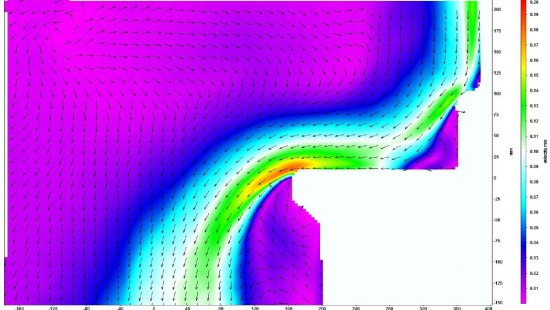Limiting the flow of cold air from windows

When buildings heated by underfloor heating in particular have windows with an unsatisfactory heat transfer coefficient, there is a noticeable flow of colder air from each window in the direction of the floor. We carried out measurements concerning the influence of windowsill temperature on the deviation or retardation of this airflow.
The airflow measurements took place under the conditions of a house with nearly zero energy consumption (nZEB). There was only floor heating in the room, the temperature of which was reduced to 22°C. One of the windowsills used were made from 16 mm thick chipboard, while the other was made from 20 mm thick cellular hardened PVC. A heating cable with a wattage of 67W (250W/m2) was attached to the bottom side of the windowsill using aluminium self-adhesive foil. The windowsill with the cable was insulated from the wall using Starlon insulation with a thickness of 6 mm.
The analysis was carried out via a particle anemometry system (PIV). The result of the analysis is a vector field of the speeds in the monitored areas. The measured values:
| Exterior -12°C / windowsill wattage 0 W Speed of the airflow under the windowsill: 0.18 – 0.2 m/s. The cold air crawls along the wall and drops with a speed of 0.18 m/s towards the floor. |
| strong>Exterior -12°C / windowsill wattage 35 W |
| Exterior -12°C / windowsill wattage 67 W The speed of flow at the windowsill is 0.2 m/s. However, the speed is already decreasing 20 cm from the edge of the windowsill, and it is only 0.01 m/s by the floor. |
| Surface temperatures for the chipboard windowsill | |||||||
| exterior temperature (°C) |
wattage of the foil (W) |
surface temperature of the window sill (°C) | foil temperature (°C) | surface temperature of the glass (°C) |
|||
|---|---|---|---|---|---|---|---|
| left | center | right | left | right | |||
| -12.0 | 67 | 44.3 | 38.0 | 35.9 | 64.5 | 47.0 | 16.0 |
| -12.0 | 50 | 38.3 | 33.7 | 31.5 | 53.2 | 39.9 | 16.1 |
| -12.0 | 35 | 33.2 | 29.6 | 28.2 | 43.5 | 33.4 | 16.3 |
| -12.0 | 0 | 19.5 | 19.5 | 19.3 | 18.8 | 17.8 | 16.2 |
| 5.0 | 67 | 48.0 | 41.3 | 37.4 | 64.6 | 45.5 | 19.4 |
| 5.0 | 50 | 41.9 | 35.4 | 33.8 | 55.3 | 40.7 | 19.3 |
| 5.0 | 35 | 35.9 | 31.3 | 29.7 | 46.4 | 35.5 | 19.2 |
| 5.0 | 0 | 21.3 | 21.5 | 21.5 | 20.7 | 20.5 | 19.4 |
| Surface temperatures for the PVC windowsill | |||||||
| exterior temperature (°C) |
wattage of the foil (W) |
surface temperature of the window sill (°C) | foil temperature (°C) | surface temperature of the glass (°C) |
|||
|---|---|---|---|---|---|---|---|
| left | center | right | left | right | |||
| -12.0 | 67 | 43.1 | 36.6 | 32.6 | 77.7 | 55.7 | 16.5 |
| -12.0 | 50 | 37.7 | 32.5 | 30.0 | 65.2 | 48.0 | 16.5 |
| -12.0 | 35 | 32.6 | 29.1 | 27.1 | 53.4 | 40.3 | 16.5 |
| -12.0 | 0 | not measured | |||||
| 5.0 | 67 | 44.1 | 40.5 | 38.5 | 77.6 | 58.0 | 19.6 |
| 5.0 | 50 | 39.8 | 36.4 | 33.3 | 67.1 | 55.3 | 19.6 |
| 5.0 | 35 | 34.9 | 32.3 | 30.0 | 54.0 | 41.6 | 19.7 |
| 5.0 | 0 | not measured | |||||
Conclusion:
There was no absolute diversion of the airflow when the outdoor temperature was -12°C, even when the wattage of the windowsill heating was 67 W (250 W/m2). However, even at a wattage of 35 W (200 W/m2) there is a significant decrease in airflow speed, which becomes practically unnoticeable. For the heating of windowsills we recommend that ECOFLOOR ADSV 10W/m heating cables be used, installed in flexible sealant directly under the windowsill. Wattage 200 W/m2 - 250 W/m2.
ECOSUN radiant heating panels with an atypical design can also be used. We are able to produce panels with a thickness of 12mm and a width of 150 mm to suit our customers´ needs. We can adapt the length of the panel to the length of the windowsill. The panels can be produced in smooth as well as sanded versions, and are fitted with a lead ending in a plug.
A suitable controller for parapet heating is the EB-Therm 800 thermostat with a sensor for the outdoor temperature, or the temperature of the windowsill. If you are interested, please contact Fenix technical support.
In Jeseník 31.8.2018
Pavel Kudelka




















